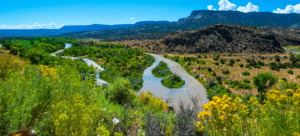New Mexico Wild Challenges USDA’s Proposed Aerial Insecticide Spraying Over Rio Chama Watershed
FOR IMMEDIATE RELEASEMedia Contact:Sally Paez, New Mexico Wild, (505) 350-0664, sally@nmwild.org
Santa Fe, New Mexico (February 21, 2024) – Today New Mexico Wild, a nonprofit 501(c)(3) grassroots organization dedicated to protecting New Mexico’s Wilderness, wildlife, and water, submitted comprehensive comments challenging the Draft Environmental Assessment (EA) issued by the USDA Animal and Plant Health Inspection Service (APHIS) for its Rangeland Grasshopper and Mormon Cricket Suppression Program in Rio Arriba County, New Mexico. The proposal includes aerial insecticide spraying over federal public lands that are popular for outdoor recreation and provide crucial habitat for imperiled bees, butterflies, and wildlife.
In the comments, New Mexico Wild highlights several critical deficiencies in the draft EA issued by APHIS, arguing that the agency failed to adequately demonstrate the necessity for the proposed project, offers an insufficient range of alternatives, and contains flawed analyses of its potential impacts on specially designated areas, wildlife habitats, cultural resources, and public health. Moreover, APHIS’s lack of transparency and failure to conduct a public scoping process raise serious procedural concerns.
The project is proposed for the Cebolla area of Rio Arriba County, primarily on Bureau of Land Management (BLM) managed lands, with some private and state-managed land involved. The Environmental Assessment (EA) lacks a thorough analysis of the impacts on specially designated federal public lands nearby. These include the Rio Chama Wilderness Study Area, the Chama Canyons Area of Critical Environmental Concern, the Rio Chama Wild and Scenic River, the Rio Nutrias (identified by BLM as eligible for Wild and Scenic River designation), and the Chama River Canyon Wilderness. Additionally, the project area is near an Important Bird Area designated by Audubon.
“This proposed project not only poses significant threats to wildlife, public health, and the integrity of the Rio Chama Watershed, but it also risks violating numerous federal statutes and regulations while doing so,” said Sally Paez, Staff Attorney at New Mexico Wild. “The potential benefits of aerial pesticide spraying are outweighed by its widespread impacts on other species, recreational users, and water quality.”
New Mexico Wild emphasizes its strong opposition to the use of carbaryl, a toxic insecticide proposed for use in the project. Carbaryl’s adverse effects on both wildlife and human health make its aerial spraying over federal public lands unacceptable.
In addition to New Mexico Wild’s comments, the organization highlights the vocal opposition of its members and supporters across the state. Over 1,300 individuals submitted comments to APHIS opposing the draft EA in a week, underscoring the broad-based public opposition to the proposed aerial spraying. Similar public opposition led to the denial of a previous aerial insecticide spray plan proposed by APHIS on lands managed by the Bureau of Land Management Taos Field Office in the summer of 2023.


